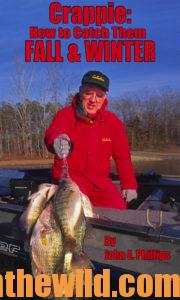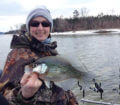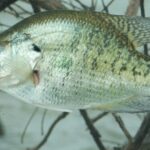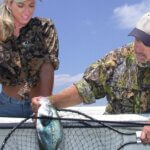Editor’s Note: Kent Driscoll of Nolensville, Tennessee, has fished for crappie for about four decades.
 At this time of year, the crappie are starting their spring migration, moving from deep water, up the creeks and near the spawning flats to prepare for the spawn. A large number of crappie will be moving to the north ends, more specifically the northwest ends, of most lakes, because these areas of the lakes heat-up first. I primarily fish the four lakes in northwestern Mississippi – Arkabutler, Enid, Grenada and Sardis lakes. Right now the crappie will be branching-off the main river channels into the main creeks on the northwest side of each lake. They’ll follow these shallow creeks into the spawning bays. In these northwestern Mississippi lakes and others across the South, the water temperature is from 55-59 degrees in many of the shallow bays. Two different patterns are taking place right now in late February and early March: the male crappie pattern and the female crappie pattern.
At this time of year, the crappie are starting their spring migration, moving from deep water, up the creeks and near the spawning flats to prepare for the spawn. A large number of crappie will be moving to the north ends, more specifically the northwest ends, of most lakes, because these areas of the lakes heat-up first. I primarily fish the four lakes in northwestern Mississippi – Arkabutler, Enid, Grenada and Sardis lakes. Right now the crappie will be branching-off the main river channels into the main creeks on the northwest side of each lake. They’ll follow these shallow creeks into the spawning bays. In these northwestern Mississippi lakes and others across the South, the water temperature is from 55-59 degrees in many of the shallow bays. Two different patterns are taking place right now in late February and early March: the male crappie pattern and the female crappie pattern.
The Male Crappie Pattern:
The male crappie will go to the shallow water first, moving to the spawning areas as the weather begins to warm-up. They’ll be looking for structure and cover in 1 to 3 feet of water. For instance, in Sardis Lake, many of the backwater bays have standing timber that will attract the males. Sardis Lake also has some shallow-water weeds that grow-up during the summer, when the lake water was down. The males will move-in to these weeds to begin to fan the beds about a week to a week and a half before the females come to lay their eggs. Now if you want to put some crappie in your freezer, fish for the males. They’ll be easier to catch because they’re in a really-aggressive mood. They’ll try and move-out any type of baitfish in the beds they’re fanning. Most of these male fish will weigh between 3/4- to 1-1/2-pounds.
 The Female Crappie Pattern:
The Female Crappie Pattern:
The females won’t be in the spawning areas right now, but they’ll be close by. They like to hold in a somewhat-deeper water than the males, and you’ll usually find them holding on structure on the edges of ditches or small creeks. I usually start out fishing in 3 to 5 feet of water to try and catch the females first, under normal conditions with stable weather. But when a cold front hits, like usually happens in the spring, often the water temperature will drop 4 or 5 degrees. Then the crappie will back-out into deeper water, often as deep as 13 to 16 feet. When that cold front hits, and the crappie move to deeper water, they get in a bad mood and are hard to catch.
How to Catch Crappie in Late February and Early March
The most-effective way for me to catch crappie is spider-rig trolling. I prefer to use the B ‘n’ M (www.bnmpoles.com) Capps & Coleman 14-foot trolling poles with a B ‘n’ M spinning reel. I’ll either be using 8- or 6-pound-test Vicious (www.getvicious.com) clear line, and I’ll be fishing a jig tipped with a live minnow. The jigheads either will be 1/8- or 3/32-ounce. My favorite colors for the heads of jigs to fish are red, orange or green. For tube bodies, I prefer Southern Pro (www.southernpro.com) 2-inch Umbrella Crappie Tubes in either chartreuse/black, chartreuse/orange or solid chartreuse.
 If I find a ditch meandering into a small bay, I’ll run half my poles, so the jigs troll through the ditch, and on the other side of my boat, I’ll have my poles trolling on the shallow flat. This way I can fish different depths and various colors of jigs, until I establish the depth where the crappie are holding, and the color of jig they prefer that day. I prefer to move really slowly and use only a single jig at this time of the year.
If I find a ditch meandering into a small bay, I’ll run half my poles, so the jigs troll through the ditch, and on the other side of my boat, I’ll have my poles trolling on the shallow flat. This way I can fish different depths and various colors of jigs, until I establish the depth where the crappie are holding, and the color of jig they prefer that day. I prefer to move really slowly and use only a single jig at this time of the year.
Second Crappie-Catching Tactic for Late February and Early March:
If I’m fishing in heavy cover, I’ll use a 12-foot pole. I can put one of these ultralight jig poles in each hand, and I can fish two jigs at one time, one shallow and one deep, until I find the crappie. Fishing the jig pole means you can get your jig in really-heavy cover. If the crappie are in the brush or the weeds, you can drop that jig in any hole you locate to catch the crappie. I pick an area that I want to fish and vertical fish with the jig, until I work that region out and catch the crappie there. I’ll be fishing these two patterns this month, and this is where I’ll be looking for and catching crappie. The end of February and first of March are great times to crappie fish, and you often catch really-big prespawn females these months, using these tactics.

 For more tips and information on catching crappie, check out John E. Phillips’ Kindle and print books “Crappie: How to Catch Them Fall and Winter” and “Crappie: How to Catch Them Spring and Summer,” or go to http://www.amazon.com/John-E.-Phillips/e/B001HP7K6O to see all of John’s books. To receive and download for free “The Crappie Catchers’ Cookbook,” by John and Denise Phillips, go to https://www.dropbox.com/sh/1tvp5nmxp8jycjf/AAAiOTM6vHolzGV44kO2oEnKa?dl=0
For more tips and information on catching crappie, check out John E. Phillips’ Kindle and print books “Crappie: How to Catch Them Fall and Winter” and “Crappie: How to Catch Them Spring and Summer,” or go to http://www.amazon.com/John-E.-Phillips/e/B001HP7K6O to see all of John’s books. To receive and download for free “The Crappie Catchers’ Cookbook,” by John and Denise Phillips, go to https://www.dropbox.com/sh/1tvp5nmxp8jycjf/AAAiOTM6vHolzGV44kO2oEnKa?dl=0










